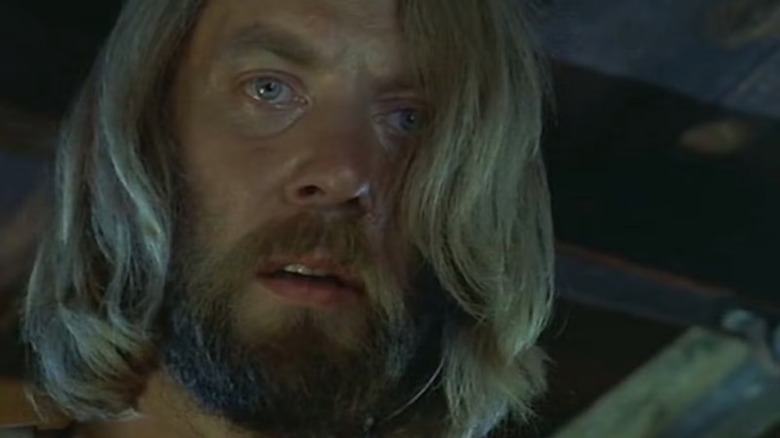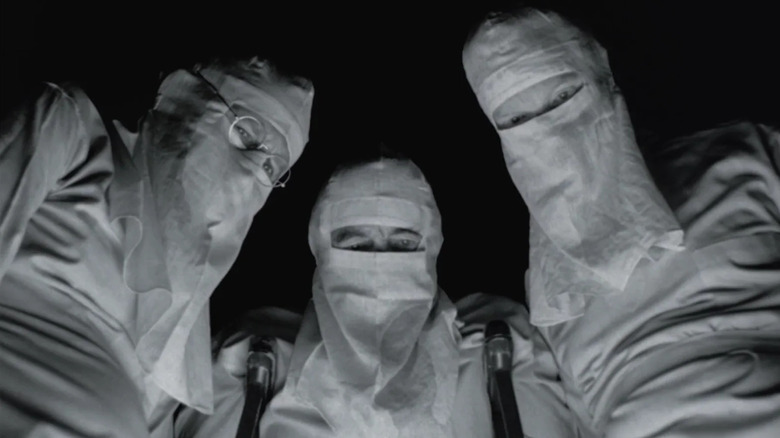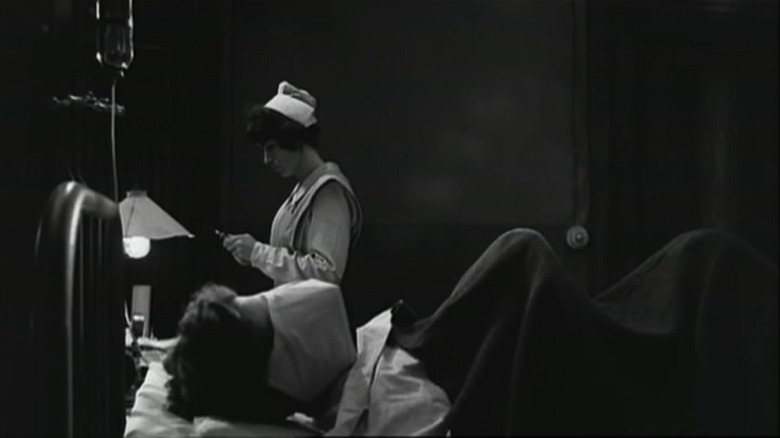Why Metallica Owns The Rights To One Of The Most Underrated War Movies Ever
We may receive a commission on purchases made from links.
Dalton Trumbo's antiwar novel "Johnny Got His Gun" was first published in 1938, and it followed the experiences of an American soldier who had been grievously injured in a violent shelling during World War I. The soldier, named Joe Bonham, lost his arms and legs in the explosion, as well as his lips, teeth, tongue, ears, and eyes. He breathes through a tracheotomy tube, strapped to a hospital bed. Joe is locked inside his own body, unable to communicate any of his thoughts. In his injured state — he knows what happened to him — Joe wants nothing more than to take his own life, but is unable to. All he can do is hammer out pleas for euthanasia in Morse Code by dropping his head on his pillow. A lot of the story involves flashbacks to Joe's childhood and teen years leading up to the war.
"Johnny Got His Gun" is one of the most tragic, damning antiwar stories every written. There is nothing glamorous about being a soldier, Trumbo argued, just a limbo state of semi-life. The title comes from the pro-WWI song "Over There" written by George M. Cohan.
In 1971, Trumbo (working with, of all people, an uncredited Luis Buñuel, the maker of "Viridiana") adapted "Johnny Got His Gun" to film. Timothy Bottoms played Joe, and was seen mostly through fantasies and flashbacks. In the present day, Joe lies in bed with a box over his face. Jason Robards played Joe's father, and Donald Sutherland played Jesus Christ, with whom Joe speaks.
The "Johnny Got His Gun" film was a bomb upon its release, and only regained traction in 1989 when it served as the inspiration (and provided a lot of music video footage) for the Metallica single "One." Because of Metallica, the film became popular again, its tragic underpinnings deeply felt by a new generation. Metallica, however, had to pay rights to the film every time they aired their music video. As such, they ended up buying the film outright.
Johnny Got His Gun meant playing One required royalties
The story goes that Trumbo and Luis Buñuel were working on a movie version of "Johnny Got His Gun" as early as 1964, a version that Buñuel was going to direct. Funding for the 1964 film fell through, however, and it didn't rematerialize for several more years. Trumbo ended up directing "Johnny" himself, the only time he ever helmed a feature. Trumbo was creative, staging the present-day sequences in black-and-white and Joe's memories in color. In drug-induced visions, as when Joe speaks with Christ, the color becomes ultra-saturated.
Both Trumbo's novel and film, as mentioned, were the primary inspiration for Metallica's "One," a seven-and-a-half-minute metal epic featured on their 1989 album "...And Justice for All." "Now that the war is through with me," the song goes, "I'm waking up, I cannot see. That there's not much left of me. Nothing is real but pain now." Then the chorus sounds "Hold my breath as I wish for death, oh please God, wake me." The music video was a hit on MTV and featured both footage and dialogue from the 1971 "Johnny Got His Gun" movie. There is a scene wherein the young Joe asks his father what democracy is, and his father reckons it has something to do with soldiers killing each other.
The music video was certainly striking, providing a heady, tragic message for a block of MTV videos that might have also included The B-52's "Love Shack." The single went Gold, while "...And Justice for All" eventually went octuple Platinum. The video was such a hit, Metallica played it at their live shows, and it became widely talked about by a whole generation.
But then came the drama with the royalties.
Metallica bought the film to avoid paying more royalties
Well, it wasn't a drama, but Metallica did find that using so much footage from "Johnny Got His Gun" in their music video started to cost them money. Every time they played the video, they owed royalties to the film's owners. Eventually, tiring of shelling out so much cash, Metallica just bought the film outright. To this day, the band owns the film rights to "Johnny Got His Gun." The original film was made for about $1 million, but made less than $770,000 at the box office.
In 2009, after Metallica bought the film, it was finally released on DVD by Shout! Factory. The DVD finally did "Johnny Got His Gun" justice, providing an interview with Timothy Bottoms, a new commentary track, and a whole documentary film on Dalton Trumbo called "Dalton Trumbo: Rebel in Hollywood." Trumbo was a colorful character who was infamously blacklisted during the Hollywood Red Scare, and stories about him — and the many films he worked on — are legion. One might recall Bryan Cranston playing Trumbo in a 2014 biopic.
Perhaps predictably, the DVD also includes the music video for "One," as well as the 1940 audio drama version wherein James Cagney played Joe. Cagney, perhaps ironically, would go on to play George M. Cohan in the 1942 musical biopic "Yankee Doodle Dandy," which is as jingoistic and pro-war as "Johnny Got His Gun" is antiwar.
If you know "Johnny Got His Gun," you have Metallica to thank. It was certainly a bigger hit in retrospect than the Metallica film "Through the Never." If you have the time and the ability to withstand soul-wounding antiwar dramas, take a few minutes to watch the "One" video. It will shake you.


